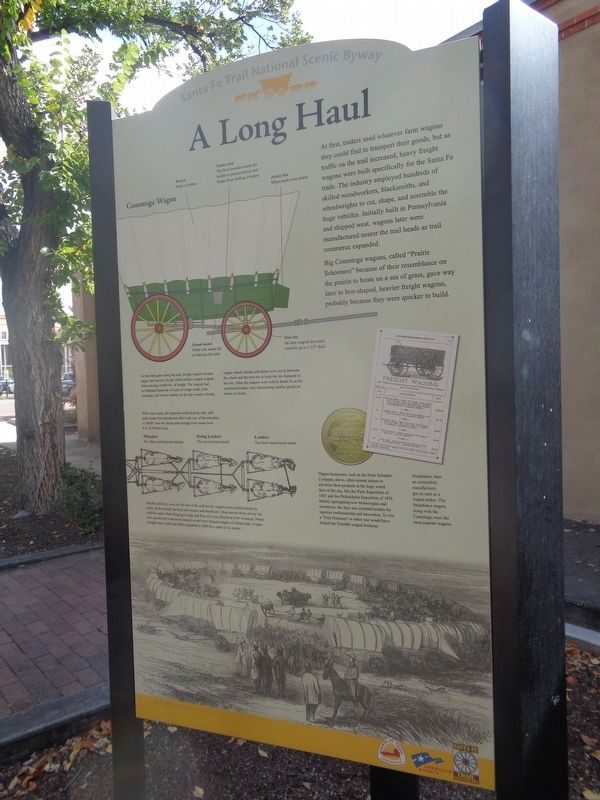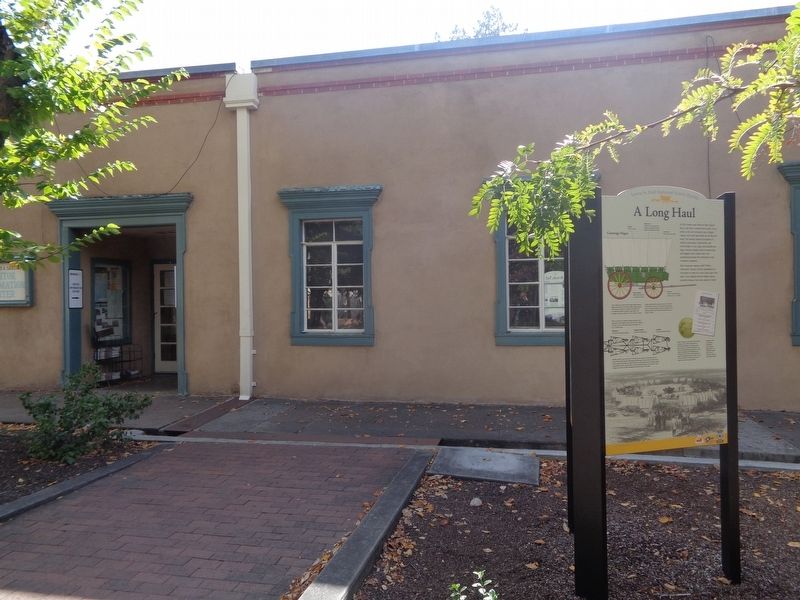Santa Fe in Santa Fe County, New Mexico — The American Mountains (Southwest)
A Long Haul
Santa Fe Trail National Historic Byway
Big Conestoga wagons, called "Prairie Schooners" because of their resemblance on the prairie to boats on a sea of grass, gave way later to box-shaped, heavier freight wagons, probably because they were quicker to build.
(photo captions:)
·As the trade grew along the trail, freight wagons became bigger and heavier. By the 1860s military supply wagons were carrying 10,000 lbs. of freight. The wagons had to withstand hundreds of miles of rough roads, river crossings, and severe weather. In the dry western climate, wagon wheels shrank and shims were put in between the wheel and the iron tire to keep the tire fastened to the rim. Often the wagons were sold in Santa Fe as the eastbound traders were transporting smaller goods on horses or mules.
·With oxen teams, the teamsters walked along side; with mule teams the muleskinner often rode one of the wheelers. A "hitch" was two mules and average mule teams were 8 to 12 hitches long.
·Initially pulled by oxen, by the end of the trail era the wagons were pulled mainly by mules. Both animals had their advantages and drawbacks. Oxen moved more slowly but could be eaten when things got tough and they were less skittish at river crossings. Mules were quicker but were more expensive and were frequent targets of Indian raids. A team of eight oxen could cost $200 compared to $600 for a team of six mules.
·Wagon businesses, such as the Peter Schuttler Company, above, often minted tokens to advertise their products at the huge world fairs of the day, like the Paris Exposition of 1867 and the Philadelphia Exposition of 1876. Mainly spotlighting new technologies and inventions, the fairs also awarded medals for superior craftsmanship and innovation. To win a "First Premium" in either one would have helped the Schuttler wagon business.
·Studebaker, later an automobile manufacturer, got its start as a wagon maker. The Studebaker wagon, along with the Conestoga, were the most popular wagons.
Erected by America's Byways.
Topics and series. This historical marker is listed in these topic lists: Industry & Commerce • Roads & Vehicles
. In addition, it is included in the Santa Fe Trail series list. A significant historical year for this entry is 1867.
Location. 35° 40.979′ N, 105° 56.262′ W. Marker is in Santa Fe, New Mexico, in Santa Fe County. Marker can be reached from Old Santa Fe Trail south of East De Vargas Street. Marker is behind the Lamy Building, in front of the Santa Fe Visitor Information Center. Touch for map. Marker is at or near this postal address: 491 Old Santa Fe Trail, Santa Fe NM 87501, United States of America. Touch for directions.
Other nearby markers. At least 8 other markers are within walking distance of this marker. Life on the Trail (here, next to this marker); The Santa Fe Trail (here, next to this marker); Lamy Building (within shouting distance of this marker); Welcome to the Pink Adobe (within shouting distance of this marker); San Miguel Church (within shouting distance of this marker); The "Oldest" House (within shouting distance of this marker); Barrio de Analco (within shouting distance of this marker); Mother Magdalen and the Sisters of Loretto (1852-1968) (about 700 feet away, measured in a direct line). Touch for a list and map of all markers in Santa Fe.
Credits. This page was last revised on November 2, 2021. It was originally submitted on November 2, 2021, by Jason Voigt of Glen Carbon, Illinois. This page has been viewed 213 times since then and 10 times this year. Photos: 1, 2. submitted on November 2, 2021, by Jason Voigt of Glen Carbon, Illinois.

